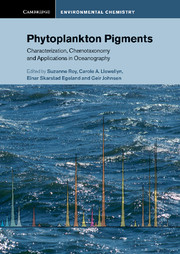Book contents
- Frontmatter
- Contents
- Contributors
- Preface
- Acknowledgements
- Abbreviations and symbols
- Part I Chlorophylls and carotenoids
- Part II Methodology guidance
- Part III Water-soluble ‘pigments’
- 9 Phycobiliproteins
- 10 UV-absorbing ‘pigments’: mycosporine-like amino acids
- Part IV Selected pigment applications in oceanography
- Part V Future perspectives
- Part VI Aids for practical laboratory work
- Part VII Data sheets aiding identification of phytoplankton carotenoids and chlorophylls
- Index
- Plate Section
- References
9 - Phycobiliproteins
Published online by Cambridge University Press: 05 March 2012
- Frontmatter
- Contents
- Contributors
- Preface
- Acknowledgements
- Abbreviations and symbols
- Part I Chlorophylls and carotenoids
- Part II Methodology guidance
- Part III Water-soluble ‘pigments’
- 9 Phycobiliproteins
- 10 UV-absorbing ‘pigments’: mycosporine-like amino acids
- Part IV Selected pigment applications in oceanography
- Part V Future perspectives
- Part VI Aids for practical laboratory work
- Part VII Data sheets aiding identification of phytoplankton carotenoids and chlorophylls
- Index
- Plate Section
- References
Summary
Introduction
Phycobiliproteins are the major light-harvesting pigments of cyanobacteria, red algae, glaucocystophytes (cyanelles) and cryptophytes (MacColl and Guard-Friar, 1987; Sidler, 1994). They are characterized by linear tetrapyrrolic chromophores, known as bilins, that are covalently bound to cysteines of the apoproteins via thioether bonds, and they harvest light for photosynthesis efficiently in the ‘green gap’ where chlorophylls absorb only poorly (Sidler, 1994). Unlike isolated chlorophyll chromophores, free bilins are photophysically unsuited as photoreceptors: they absorb light only poorly and their excited states are very short lived, thereby leading to rapid conversion of excitation energy to heat (Scheer, 1982; Braslavsky et al., 1983; Falk, 1989). These properties also prevail in denatured biliproteins. The photophysical properties of native biliproteins are, by contrast, much more favourable: the light absorption of the chromophores is increased by almost one order of magnitude and the excited lifetimes by four orders of magnitude, which, in combination, render them excellent photoreceptors. The absorption of individual chromophores can, moreover, be shifted by almost 100 nm, and also the circular dichroism of biliproteins is modulated drastically during folding (see Scheer, 2003 and Kupka and Scheer, 2008 for leading references). The underlying nature of these molecular adaptations, which are still only partly understood, consists mainly of extensive chromophore protein interactions by which the chromophore conformation and dynamics are modulated. Covalent binding to the apoproteins appears to be important in assisting these interactions. Although cysteine mutants indicate that covalent binding is not absolutely necessary for function (Gindt et al., 1994; Jorissen et al., 2002; Inomata et al., 2006), it does assist functional optimization (Gindt et al., 1994) because it stabilizes both the labile chromophores (Scheer, 1982) and proteins (Anderson and Toole, 1998; Shen et al., 2008a, b). In cyanobacteria and red algae, up to four bilin chromophores are post-translationally attached, via thioether bonds, to specific cysteines of up to a dozen or even more individual proteins (Sidler, 1994); further, an additional modification in β-subunits is the methylation of a conserved asparagine-72 (Swanson and Glazer, 1990; Schluchter et al., 2010). Chromophore attachment also appears to be a pre-requisite for the assembly of phycobilisomes (PBS) (Anderson and Toole, 1998) which are the light-harvesting antennae of blue-green algae and of both red and cryptophyte algae.
- Type
- Chapter
- Information
- Phytoplankton PigmentsCharacterization, Chemotaxonomy and Applications in Oceanography, pp. 375 - 411Publisher: Cambridge University PressPrint publication year: 2011
References
- 2
- Cited by



